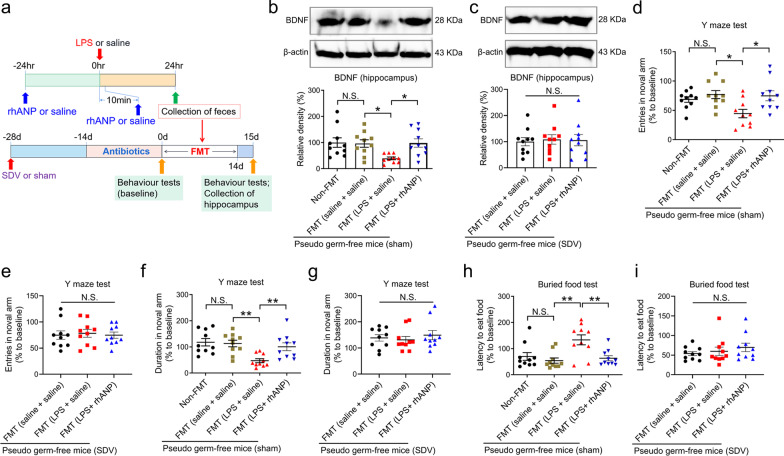Fig. 5.
Key role of SDV in the improving effects of rhANP on disturbed gut microbiota-induced cognitive dysfunction after LPS injection. a Treatment schedule. The pseudo germ-free (PGF) mouse model was created by administering large doses of antibiotics to mice for 14 consecutive days. The PGF mice underwent subdiaphragmatic vagotomy (SDV) or sham operation 28 days before fecal microbiota transplantation (FMT). The PGF mice were given by gavage fecal bacteria suspension from lipopolysaccharides (LPS) or 0.9% saline-injected mice with or without recombinant human ANP (rhANP) treatment. On day 15, hippocampus was collected. Western blot analysis of BDNF in the hippocampus of PGF mice received sham operation (b; one-way ANOVA: F3,36 = 4.216, P = 0.0118) or SDV (c; one-way ANOVA: F2,27 = 0.05614, P = 0.9455). The entries in the novel arm in the Y maze test in the PGF mice subjected to sham operation (d; one-way ANOVA: F2,27 = 4.621, P = 0.0078) or SDV (e; one-way ANOVA: F2,27 = 0.07938, P = 0.9239). The duration in the novel arm in the Y maze test in the PGF mice subjected to sham operation (f; one-way ANOVA: F3,36 = 6.602, P = 0.0011) or SDV (g; one-way ANOVA: F2,27 = 0.3912, P = 0.6800). The latency to eat food in the buried food test in the PGF mice subjected to sham operation (h; one-way ANOVA: F3,36 = 6.701, P = 0.0010) or SDV (i; one-way ANOVA: F2,27 = 0.7501, P = 0.4819). Data are shown as mean ± SEM, n = 10/group. *P < 0.05, **P < 0.01; N.S. not significant

